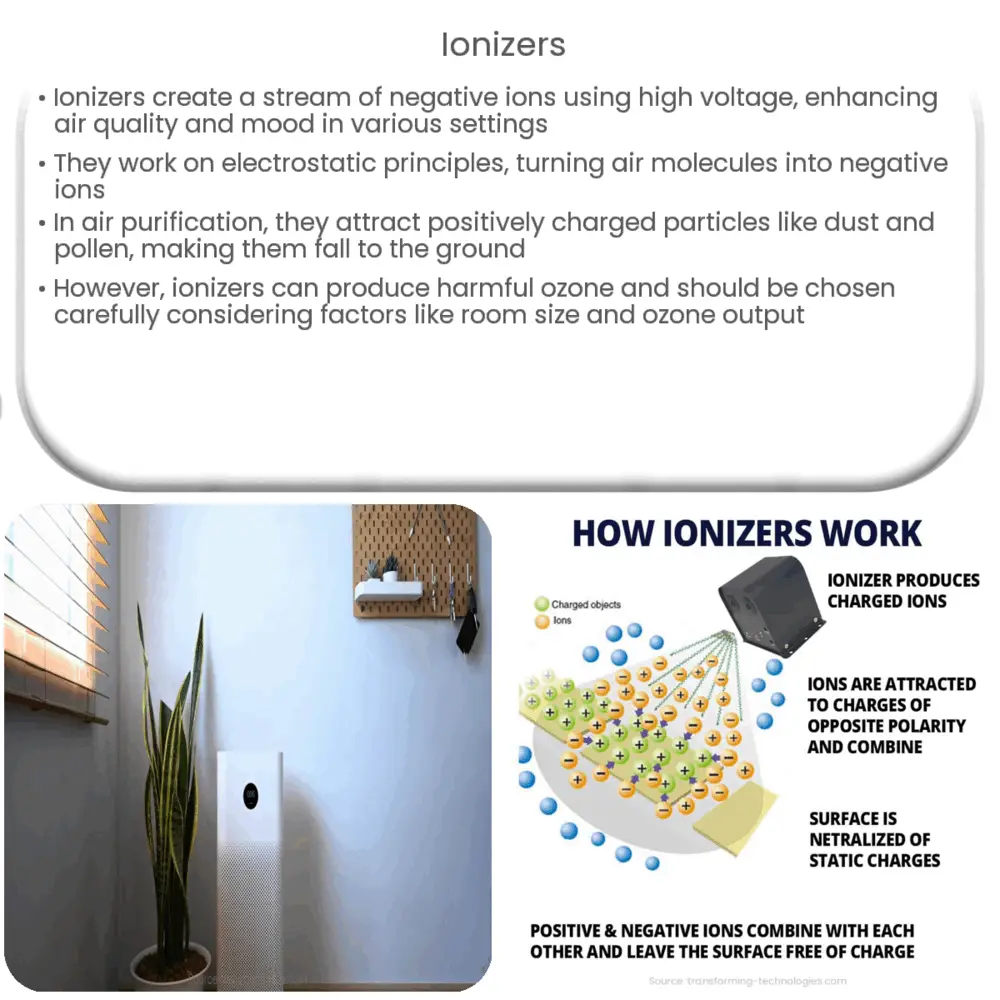Explore the working of ionizers, their role in air purification, potential health benefits, drawbacks, and buying guide.

Understanding Ionizers
An ionizer is a device that uses high voltage to create a stream of negative ions which are then released into the atmosphere. These devices are utilized in various settings, ranging from homes to offices, healthcare settings, and even industrial environments. Ionizers hold a multitude of purposes, from air purification to enhancement of mood and overall health.
How do Ionizers Work?
The operation of ionizers is largely based on the principle of electrostatics. By applying a high voltage, they impart a negative charge to molecules of air, thus turning them into negative ions. These negative ions, bearing an extra electron, are subsequently propelled into the surrounding atmosphere. The fascinating science behind this mechanism can be further explained as follows:
- The ionizer applies high voltage to a series of built-in needles, generating an intense electric field around the tips of the needles.
- This electric field ionizes the surrounding air molecules, stripping them of electrons and creating positive ions.
- The freed electrons, due to their high kinetic energy, attach themselves to other air molecules, thus forming negative ions.
The now ionized air is dispersed into the environment, where it can interact with other particles.
Role of Ionizers in Air Purification
One of the key applications of ionizers is in the realm of air purification. Their ability to generate negative ions enables them to attract particles such as dust, pollen, mold, and bacteria, which typically carry a positive charge. This mechanism can be broken down as follows:
- Negative ions generated by the ionizer bind to positively charged particles in the air, such as dust and allergens.
- This binding increases the mass of these particles, making them heavier and causing them to fall to the ground.
- The fallen particles can be easily removed by regular cleaning, thereby improving the air quality.
Despite the straightforward process, it’s worth noting that the efficiency of ionizers in purifying air greatly depends on various factors such as the size of the room, the amount of ionization, and the presence of other air cleaning devices.
The Health Implications of Ionizers
Ionizers are known to have potential health benefits, particularly in improving air quality. Research has shown that exposure to negative ions may lead to reduced instances of respiratory issues, allergies, and even mental health problems like depression and anxiety. The enhanced air quality may also contribute to a general sense of well-being and improved sleep patterns.
However, it’s important to underline that while ionizers can have positive impacts, they should not be considered a complete solution to indoor air pollution. They are best used in conjunction with other air cleaning technologies and proper ventilation.
Understanding the Potential Downsides
Despite their benefits, ionizers also have potential downsides. One such drawback is that they can produce ozone as a by-product, which can be harmful if present in high concentrations. Moreover, since ionizers make pollutants heavier and cause them to fall onto surfaces, inadequate cleaning can lead to re-suspension of these pollutants into the air, causing potential health risks.
Choosing the Right Ionizer
When choosing an ionizer, it’s important to consider a few key factors:
- Size of the space: Larger spaces may require more powerful ionizers.
- Specific needs: If someone in your household has allergies, you might consider an ionizer designed to tackle allergens.
- Ozone production: Look for devices certified to produce minimal or no ozone.
- Noise level: If the device will be used in a bedroom or quiet office, consider its noise output.
Conclusion
In conclusion, ionizers are innovative devices that can play a significant role in improving indoor air quality, potentially leading to a range of health benefits. However, like all technologies, they have their limitations and potential downsides, such as ozone production. Therefore, when choosing an ionizer, it’s crucial to consider factors such as the size of the space, specific needs, and the device’s ozone output. By making an informed decision, you can enjoy cleaner air and a healthier environment.

